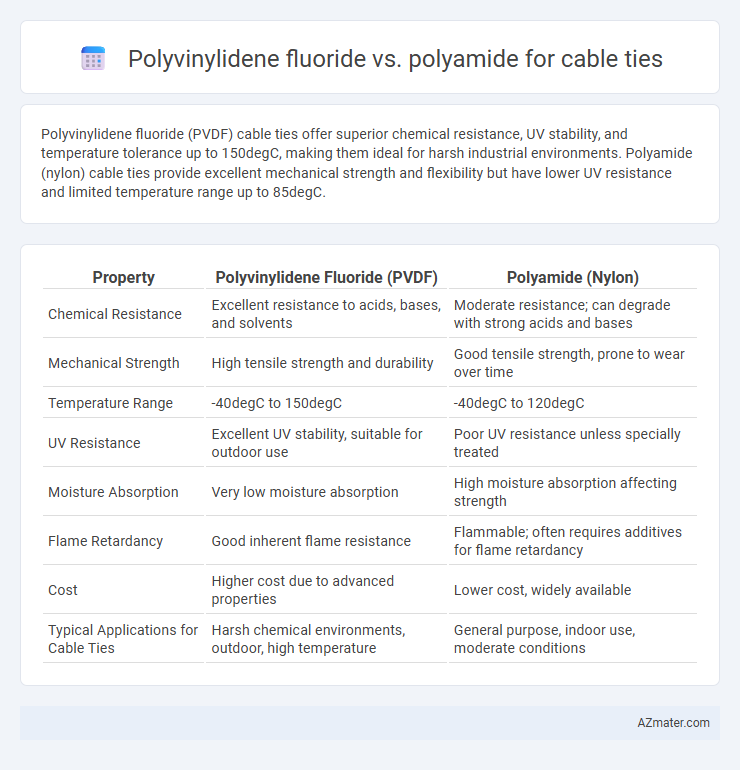Polyvinylidene fluoride (PVDF) cable ties offer superior chemical resistance, UV stability, and temperature tolerance up to 150degC, making them ideal for harsh industrial environments. Polyamide (nylon) cable ties provide excellent mechanical strength and flexibility but have lower UV resistance and limited temperature range up to 85degC.
Table of Comparison
| Property | Polyvinylidene Fluoride (PVDF) | Polyamide (Nylon) |
|---|---|---|
| Chemical Resistance | Excellent resistance to acids, bases, and solvents | Moderate resistance; can degrade with strong acids and bases |
| Mechanical Strength | High tensile strength and durability | Good tensile strength, prone to wear over time |
| Temperature Range | -40degC to 150degC | -40degC to 120degC |
| UV Resistance | Excellent UV stability, suitable for outdoor use | Poor UV resistance unless specially treated |
| Moisture Absorption | Very low moisture absorption | High moisture absorption affecting strength |
| Flame Retardancy | Good inherent flame resistance | Flammable; often requires additives for flame retardancy |
| Cost | Higher cost due to advanced properties | Lower cost, widely available |
| Typical Applications for Cable Ties | Harsh chemical environments, outdoor, high temperature | General purpose, indoor use, moderate conditions |
Introduction to Cable Ties: Material Matters
Polyvinylidene fluoride (PVDF) and Polyamide (PA) are two prominent materials used in cable ties, each offering unique chemical and mechanical properties. PVDF provides excellent resistance to UV radiation, chemicals, and high temperatures, making it ideal for harsh outdoor and industrial environments. In contrast, Polyamide is favored for its strength, flexibility, and cost-effectiveness in general-purpose applications, with varying grades available to meet diverse performance requirements.
Overview of Polyvinylidene Fluoride (PVDF)
Polyvinylidene fluoride (PVDF) is a high-performance fluoropolymer known for its excellent chemical resistance, thermal stability up to 150degC, and strong mechanical properties, making it ideal for demanding cable tie applications in harsh environments. Its inherent UV resistance and low moisture absorption ensure durability and long-term performance in outdoor and industrial settings. Compared to polyamide, PVDF offers superior resistance to acids, bases, and solvents, providing enhanced reliability where chemical exposure is a concern.
Understanding Polyamide (Nylon) Cable Ties
Polyamide cable ties, also known as nylon cable ties, are renowned for their excellent tensile strength, flexibility, and resistance to abrasion, making them ideal for securing cables in demanding environments. Compared to polyvinylidene fluoride (PVDF), polyamide offers superior cost-effectiveness and good chemical resistance, though it may be less resistant to UV radiation and harsh chemicals. Understanding these properties helps in selecting nylon cable ties for applications requiring durability and versatility, especially in electrical and automotive industries.
Mechanical Strength Comparison: PVDF vs Polyamide
Polyvinylidene fluoride (PVDF) exhibits superior mechanical strength compared to polyamide (PA) when used in cable ties, offering enhanced tensile strength and improved resistance to elongation under load. PVDF's higher modulus of elasticity provides greater rigidity and durability in demanding environments, making it suitable for heavy-duty applications. In contrast, polyamide cable ties typically demonstrate more flexibility but are more prone to wear and mechanical fatigue over extended use.
Chemical Resistance and Environmental Suitability
Polyvinylidene fluoride (PVDF) cable ties exhibit superior chemical resistance against acids, bases, and solvents, making them ideal for harsh industrial environments. Polyamide (PA) cable ties offer good overall chemical resistance but degrade faster under prolonged exposure to UV radiation and moisture, limiting their use outdoors. PVDF's high resistance to temperature extremes and corrosive chemicals ensures better environmental suitability in aggressive settings compared to polyamide.
Temperature Performance: Heat and Cold Resistance
Polyvinylidene fluoride (PVDF) cable ties exhibit superior temperature performance, maintaining stability and mechanical strength between -40degC and 150degC, making them ideal for high-temperature applications. Polyamide (nylon) cable ties, while versatile, typically operate effectively within a narrower temperature range of -40degC to 85degC, limiting their use in extreme heat conditions. PVDF's exceptional heat resistance and chemical stability outperform the thermal limits of polyamide, ensuring durability in harsh environments where thermal endurance is critical.
UV Stability and Outdoor Applications
Polyvinylidene fluoride (PVDF) outperforms polyamide (PA) in UV stability, maintaining its mechanical properties and resisting degradation under prolonged sunlight exposure. PVDF's superior resistance to ultraviolet radiation makes it ideal for outdoor cable tie applications where long-term durability is essential. Polyamide tends to absorb moisture and degrade faster in UV-rich environments, limiting its effectiveness in harsh outdoor conditions.
Flammability and Electrical Insulation Properties
Polyvinylidene fluoride (PVDF) offers superior flame retardancy with a high limiting oxygen index (LOI) around 44%, making it highly resistant to ignition in cable tie applications, whereas polyamide (PA) exhibits moderate flammability with LOI values typically between 20-25%. PVDF also excels in electrical insulation properties, featuring a high dielectric strength of approximately 34 kV/mm and low dielectric constant, which ensures reliable performance in harsh electrical environments. In contrast, polyamide demonstrates good but comparatively lower electrical insulation, with dielectric strength near 20-25 kV/mm, making PVDF the preferred choice for high-performance cable ties requiring enhanced fire safety and electrical resistance.
Cost Considerations and Market Availability
Polyvinylidene fluoride (PVDF) cable ties generally come at a higher cost compared to polyamide due to their superior chemical resistance and thermal stability, making them ideal for demanding industrial applications. Polyamide cable ties dominate the market availability, widely used because of their cost-effectiveness and adequate performance in standard environments. Market pricing reflects PVDF's niche use in specialized sectors, whereas polyamide's broad adoption ensures consistent supply and affordability.
Best Applications: Choosing the Right Material for Your Cable Tie
Polyvinylidene fluoride (PVDF) is ideal for cable ties requiring superior chemical resistance, UV stability, and high-temperature endurance, making it suitable for harsh environments such as aerospace, marine, and chemical industries. Polyamide (PA), known for its excellent mechanical strength, flexibility, and cost-effectiveness, is commonly used in general-purpose applications like electrical wiring, automotive, and home organization. Selecting the right material depends on exposure conditions and performance requirements, with PVDF preferred for extreme environments and polyamide favored for versatile, everyday use.

Infographic: Polyvinylidene fluoride vs Polyamide for Cable tie
 azmater.com
azmater.com